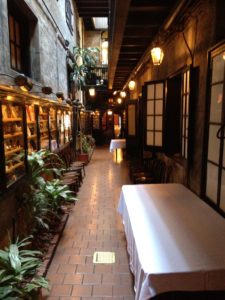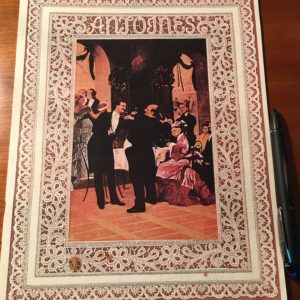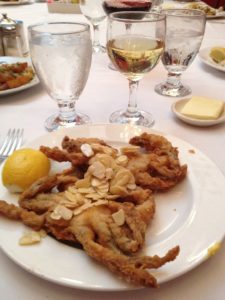By Paul Freedman (Guest Contributor)
Few elegant restaurants have had their names recorded in the titles of best-selling books and only one that I know of was mentioned prominently in a Bugs Bunny cartoon. Antoine’s in New Orleans has both distinctions. Founded in 1840, nearly wrecked by financial difficulties and Hurricane Katrina, Antoine’s is still going strong as the oldest US restaurant owned by a single family.

Antoine’s Restaurant- New Orleans
Dinner at Antoine’s was a wildly popular mystery novel by the once-celebrated author Frances Parkinson Keyes that appeared in 1948. The first scene depicts the crowds waiting outside the restaurant, which took reservations only for its socially prominent regulars. The opening scene is a dinner party held in the glowing, red “1840 Room” starting a complicated story of passion and betrayal. So familiar was the restaurant to the American public that the concise title needed no elaboration.
The 1951 cartoon French Rarebit merely refers to Antoine’s, but again its fame requires no explanation. Bugs Bunny falls off a carrot truck and it turns out he is in Paris. Before he can take his bearings, two rival chefs grab him and a dispute ensues over who gets the right to cook the rabbit. The rest of the story involves a complicated escape that begins with a promise on the part of the rabbit that he knows an infallible recipe for “Louisiana Back Bay Bunny Bordelaise” as made at Antoine’s. The chefs are impressed and one of them asks, with something approaching awe, “Antoine’s, of New Orleans?” Bugs Bunny retorts, in his inimitable fashion, “I don’t mean Antoine’s of Flatbush”.

Interior courtyard at Antoine’s
If it has lost that universal level of fame, Antoine’s remain a wonder, both for its marvelous food and its timelessness. It has over a dozen variously decorated dining rooms, ranging in size from the Large Annex and the Japanese Room (the latter seating 200) to the tiny Tabasco Room with a capacity of six and the only slightly larger Escargot Room, originally the preserve of a private dining society. The menu is still in French, although there is an English translation provided (but only since the 1990s). The restaurant’s most famous specialty is Oysters Rockefeller, oysters cooked in their shells with a green sauce whose ingredients are known only to the owner and maybe one or two others.
From the beginning until sometime in the 1960s Boeuf Robespierre was a featured entrée, invented by the original Antoine Alciatore when he was a teenage chef in Marseilles. For the Prince Talleyrand, the eminent diplomat and political intriguer, Antoine prepared a special beef tenderloin saignant (i.e. rare enough to be still bloody) served with a sauce of beef stock, sweetbreads and chicken livers. Summoned from the kitchen to receive the great man’s compliments, the youthful chef was asked what he called the dish. He actually hadn’t thought to name it but, on impulse, he said “Boeuf Robespierre,” remembering his father’s description of the grisly execution of the French revolutionary leader.

Antoine’s menu cover
There are in addition at least two flambé dishes, Cherries Jubilee and Café Brulôt Diabolique (coffee mixed with brandy and spices), set alight at the table. Before the Second World War the restaurant owner, Jules Alciatore, said the kitchen could prepare over 1,000 different dishes and they had 560 recipes just for eggs. The list of marvels is endless.

Café brulôt diabolique
Thick, rich French sauces, waiters who seem to have been there since time began and a wonderfully formal but warm-hearted atmosphere, the restaurant seems to be a relic from a distant era even alongside the other grand establishments of the French Quarter such as Galatoire’s or Arnaud’s. When Anthony Bourdain visited in 2008 for an episode of No Reservations, he dined on Oysters Rockefeller, soft-shell crabs with brown butter, Tournedos Marchand de Vin and Baked Alaska. Bourdain assumed these were all prepared just for his visit as some sort of homage or ironic gesture to the restaurant’s past and was incredulous at being shown they were all on the normal menu and ordered all the time.

Soft shell crab at Antoine’s
For most of its history Antoine’s has identified its food as “French,” but it really amounts to a combination of French, Louisiana Creole and its own inventions. Perhaps to reaffirm its own pedigree, it either lacks or de-emphasizes certain popular creole dishes an outsider visiting New Orleans might expect: no jambalaya, only in recent years is gumbo given any prominence and alligator soup is new. It’s hard to think of another restaurant in this country serving European or American food that doesn’t list any pasta dishes.
Some changes are being made in order to draw in new patrons and to take advantage of a revival of the New Orleans restaurant scene and of the beleaguered city as a whole. One of the dining rooms was converted into the Hermes Bar with an informal, convivial atmosphere and a more grazing, small-plates set of dining options. The website is updated and there are special offers and promotions, something unthinkable in the past. The essential spirit of the restaurant, however, is intact and its physical and culinary restoration has made it more attractive than at any time in the recent past.
***
Paul Freedman is the Chester D Tripp Professor of History at Yale University. He specializes in medieval social history, the history of Spain, the study of medieval peasantry, and medieval cuisine.
His newest book, Ten Restaurants That Changed America (Norton, 2016) will be available in September 2016 and may be pre-ordered here.
